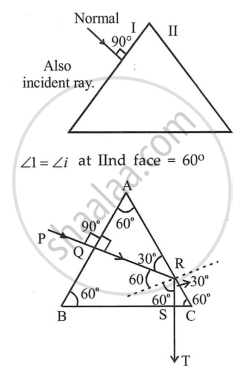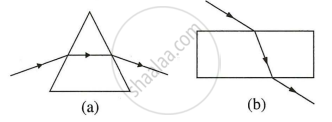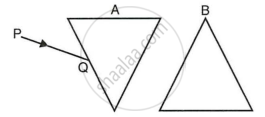Advertisements
Advertisements
प्रश्न
A ray of light is normally incident on one face of an equilateral glass prism. Answer the following:
What will be the angle of incidence at the second face of the prism?
उत्तर
As the prism is equilateral, A = 60° and r1 = 0°. So, at the second face of the prism, the angle of incidence will be 60°.

APPEARS IN
संबंधित प्रश्न
Diagrams (a) and (b) in figure below show the refraction of a ray of light of single colour through a prism and a parallel sided glass slab respectively.

- In each diagram, label the incident, refracted, emergent rays and the angle of deviation.
- In what way the direction of emergent ray in the two cases differ with respect to the incident ray? Explain your answer.
A ray of light is normally incident on one face of an equilateral glass prism. Answer the following:
What is the angle of incidence on the first face of the prism?
In following figure shows two identical prisms A and B placed with their faces parallel to each other. A ray of light of single colour PQ is incident at the face of the prism A. Complete the diagram to show the path of the ray till it emerges out of the prism B.

[Hint: The emergent ray out of the prism B will be parallel to the incident ray PQ]
A ray of light suffers refraction through an equilateral prism. The deviation produced by the prism does not depend on the ______.
Assertion: The light emerges from a parallel-sided glass slab in a direction perpendicular to that in which enters the glass slab.
Reason: The perpendicular distance between the original path of the incident ray and the emergent ray coming out of the glass slab is called lateral displacement of the emergent ray of light.
Assertion: When a pencil is partly immersed in water and held obliquely to the surface, the pencil appears to bend at the water surface.
Reason: The apparent bending of the pencil is due to the refraction of light when it passes from water to air.
In an experiment to trace the path of a ray of light through a glass prism for different values of angle of incidence a student would find that the emergent ray:
How will you use two identical prisms so that a narrow beam of white light incident on one prism emerges out of the second prism as white light? Draw the diagram.
Explain the phenomenon of dispersion of white light through a glass prism, using suitable ray diagram.
The diagram below shows the path of a blue ray through the prism:
- Calculate the critical angle of the material of the prism for blue colour.
- What is the measure of the angle of this prism (A)?
- Which colour should replace the blue ray, for the ray to undergo Total Internal Reflection?

